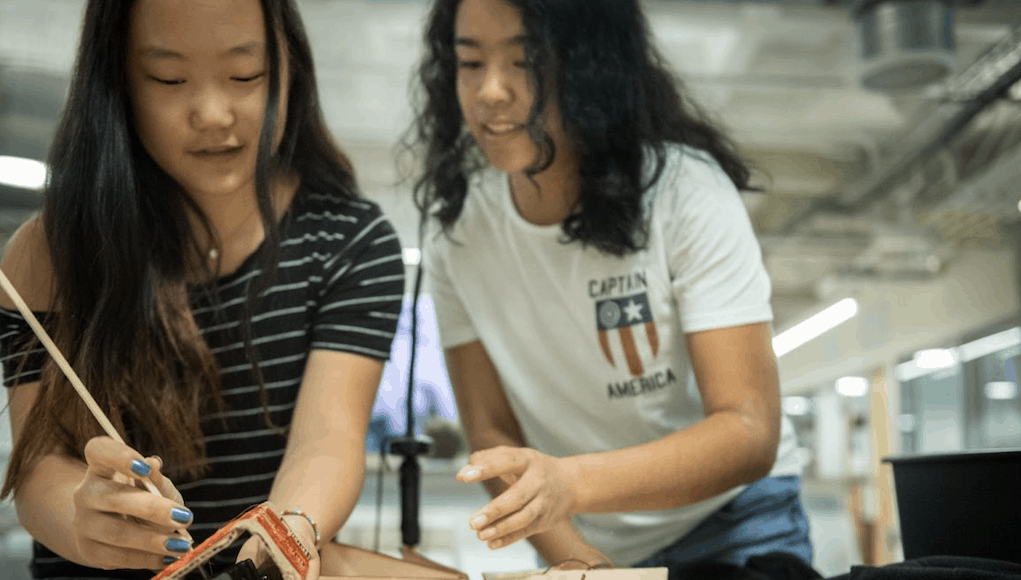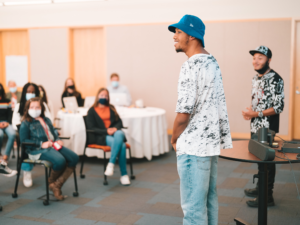Why Schools Need Research and Design Space

“This morning kids were 3D printing some new designs. They were joined by a group working on a geometry problem. At lunch time, the Code Club worked on their snake robots (ironically coded in Python), then a team worked on unicorn designs. After the Engineering and Physics class, a group of kids worked on four panes that illustrate The Kite Runner.” Jayne Everson, Director of Robotics + Engineering and R+D Experience Lead at Beaver Country Day School summarized the eclectic forms of engagement experience on one day at the year-old Research + Design Center.
Nationally known for its forward-leading education, Beaver Country Day School released a Student Engagement Study today outlining the ways that big flexible spaces can unleash learning—in some expected and surprising ways.
To determine the impact of the Research + Design Center during its first year, three graduate students from the Harvard Graduate School of Education spent time interviewing, observing and surveying students and faculty. The study found that 95% of students understand topics better when learning in a collaborative, project-based space.
Replacing the old dark library, the school’s new 38,000 square foot Research + Design Center is a state-of-the-art innovation hub designed to promote student-driven learning. The Center hosts regularly scheduled classes, project teams, clubs and lots of drop-ins.
Beaver serves almost 500 secondary students in the Boston suburb of Chestnut Hill (just south of Boston College). The nearly 100 year old John Dewey influenced school has a tradition of project-based collaborative learning.
Head of School Peter Hutton explained that the school is committed to what they call the New Basics: creative problem-solving, collaboration, iteration, visual communication, empathy, tech and media literacy and presentation skills.
To boost effectiveness and agency, they want students to be able to answer two key questions: “What am I doing?” and “Why am I doing it?”

Using A Big Flexible Space
Teachers told researchers the purpose of the R+D Center is to:
- Empower and inspire students to make change through innovation by calling on the New Basics;
- Provide the mindset and tools to integrate research, design, and technology into project-based learning; and
- Use projects to build agency, motivation, skills and understanding
One of the greatest benefits of the R+D Center has been the way that it enables students who wouldn’t normally cross paths to collaborate given different age groups or interests. Associate Head of School Nancy Caruso recalls a time when 9th grade students were considering ways to illustrate the laws of physics. They happened to be working in the R+D Center at the same time as a 6th grade humanities class. The presence of the younger students inspired the 9th graders to create their carnival games with the engagement of the 6th graders in mind—ultimately, ensuring that the project was designed with purpose.
Frequently, a teacher will frame a project in a traditional classroom and the students will spill out to other parts of the facility, including the Center. Hutton explained, “We see students and teachers using the open spaces in the hallways more since the addition.”
Beaver also set up spaces in the hallways for students to use as social areas and due to the underlying influences and culture of collaboration the students continue to use these areas as co-working spaces. “It’s important to democratize the space, to hand it over to the kids,” added Hutton.
Not only has the R+D addition been an asset to the students, but there has been a dramatic turn in teacher learning (and unlearning as well). Teachers who had a more traditional education themselves are feeling inspired in new ways by the flexible space and project-based mindset. It is not uncommon for faculty to see “a 6th grader showing a teacher how to solder” or for teachers to lean heavily on students in the R+D Center for assisting other students. Almost nine in ten students reported being confident in how to use the R+D Center.
The Beaver team has looked to art and theatre teachers for inspiration in how to manage the large space because “they have been using big messy spaces like this for a long time.” The Beaver team even worked with acoustical engineers to try and maximize the comfort and effectiveness of the new space.
The R+D Center is a great example of a well used flexible learning space, what we called the top trend of 2018. Beaver joins leading schools worldwide rethinking learning experiences and environments to boost “the New Basics”.
City As Classroom
For a decade, Beaver 10th and 11th graders have been spending a term at NuVu Studio on Mass. Ave. between Harvard and MIT in Cambridge. The urban term gives learners a rich place-based set of experiences. On a recent visit we observed Beaver students making ethnographic and economic maps of Cambridge after a walking tour. In a science studio, students were plotting and visualizing the type and intensity of smells identified on a similar walking tour.
The Beaver school practices what it preaches. It not only engages with the students and the nearby innovative academies, it also engages the parents of their students in “purpose-based” design activities to instill a culture of human-centered innovation even deeper in the Beaver community.
For the centennial of Beaver, the team has decided to look forward 100 years, rather than looking retrospectively at their past. This eye towards the future is an essential part of the Beaver mindset. They are creating a series of events on campus and across the country to celebrate and proliferate the Beaver experience and values.
For, more see:
- Studio-Based Learning and Self-Directed Students at NuVu
- Workspace Education: A Creative Approach to Competency- and Project-Based Science
- A Library Transformed (feature on Elizabethton High School, an XQ Super School)
- Mythbusters: Flexible Learning in Middle School (feature on Singapore American School)
Stay in-the-know with innovations in learning by signing up for the weekly Smart Update.
This post was originally published on Forbes.








Ann Schuster
This is an exciting concept but my question is “Who directs/oversees this facility?” I would hope it would be a certified school librarian. These indispensable staff members are experts in collaboration, resource selection, and curricular integration. They specialize in design thinking, developing problem based learning strategies, and Makerspace implementation. There may be one in the school featured in this article but if there is, which I doubt, there is no mention. What a shame....